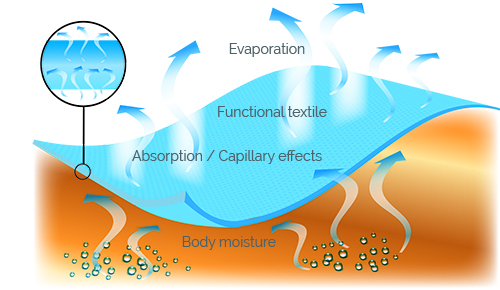-
- Languages
- Turkish
- Rudolf Worldwide
- RUDOLF Germany
- HUB 1922
- RUDOLF Italy
- RUDOLF Indonesia


The intelligent Moisture Management Technology for synthetics or their blends.
Perspiration accompanies man 365 days a year and 24 hours a day and is a natural reaction for transporting excess heat, which is caused by activity, high ambient temperature or fever away from the body. How much perspiration is produced depends on the degree of physical activity and genetic predisposition. During the thermo-regulative process of perspiring, perspiration is formed as a colourless and odourless secretion by more than 3 million eccrine perspiratory glands of the human body. At night healthy human beings produce around half a litre of perspiration. At around 20° C and with work that causes average exertion man can lose 6 litres of perspiration per day. At times of very high physical exertion the quantity of perspiration may well reach up to 4 litres an hour.
By supporting the thermal regulation of the human body, clothing may significantly contribute to the physiological comfort. Due to their numerous advantages, such as light weight, high durability and wear resistance, distinct easy care and fast drying, textiles made of synthetic fibres are increasingly popular.
The hydrophobic behaviour of synthetic fibres, if they are unfinished, is a physiological deficit which has to be offset by high-performance hydrophilic properties to be able to produce proper functional textiles.
Only perfectly prepared textiles are in a position to display optimum moisture management effects. Textiles are extremely suitable for this kind of active finish if they fulfil the following prerequisites.
Textiles must be able to absorb arising moisture by capillary force which is also known as wicking effect. These capillary forces increase, when the space between the individual textile fibres decreases.
The evaporation of moisture, which is absorbed by the textile, depends to a large extent on the size of the textile surface and less on the fibre type.
Moist textiles on the skin feel very unpleasant. In contrast to articles made of synthetic fibres cellulosic clothing absorb and retain moisture very well.
If materials used have a high fabric thickness, more moisture is absorbed compared with thin fabric. Especially with thick cotton articles slow drying is the result of a combination of unfavourable volume-surface ratio and high moisture-retaining properties of cellulosics.
The physiological properties are very unfavourable.
IC (Identical Chemistry)
Soil/Stain Release
IC (Identical Chemistry)
Dual Moisture Management Technology
Fast-drying, Cooling-Down-Control

With HYDROCOOL®, the intelligent moisture management technology, synthetic articles are functionalised to become textiles for skin-contact that can be worn perfectly next to the skin.
We are happy to assist you in implementing the process on your articles.